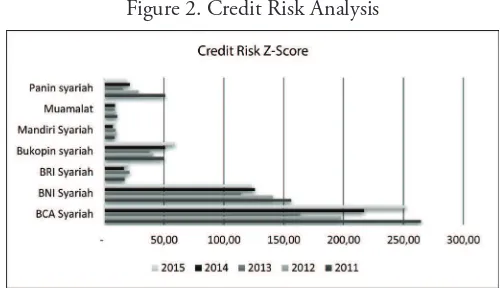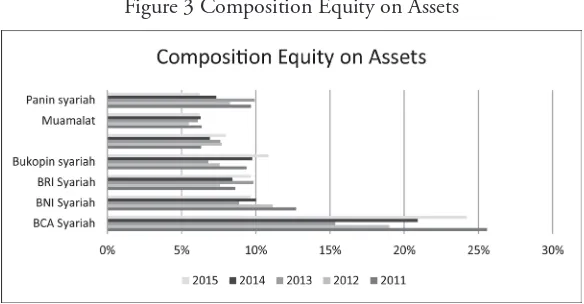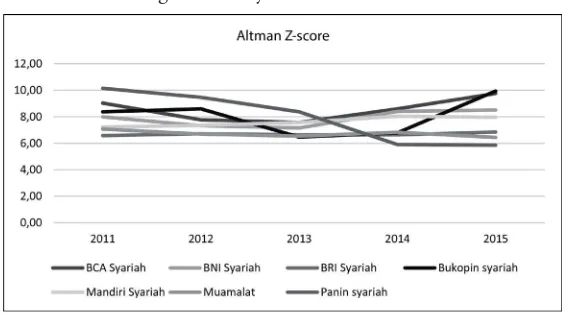Received: February 4, 2017; Revised: April 16, 2017; Accepted: April 23, 2017
Abstract.Risk of Debt-Based Financing on Indonesian Islamic Banking.
he purpose of this study is to know the risk of debt-based inancing in Islamic banking in Indonesia by using an accounting based calculation, those are NPF analysis, Credit risk Z-score and Altman Z-score. his study is telling about the risk of debt-based inacing on Indonesian Islamic banking using an accounting based measurement, those are NPF analysis, Credit Risk Z-score analysis and Altman Z-score analysis. he data was obtained from 2011 to 2015 from the website of each bank. he result is a risk on debt-based inancing on Indonesian Islamic is low. he measurement using 3 accounting based measurement tool gives a consistent result, that is Indonesian Islamic banking use a debt-based inancing have a high inancial stability and a low risk.
Keyword: inancing risk management, debt-based inancing, accounting-based
Abstrak. Risiko Pembiayaan Berbasis Hutang pada Perbankan Syariah di Indonesia. Tujuan dari penelitian ini adalah untuk mengetahui resiko debt-based inancing pada perbankan islam di Indonesia dengan menggunakan perhitungan accounting-based yaitu NPF analysis, Credit risk Z-score dan Altman Z-score. Penelitian ini menjelaskan resiko pada debt-based inancing perbankan islam yang ada di Indonesia menggunakan accounting based measurement, yaitu NPF analysis, Credit Risk Z-score analysis dan Altman Z-score analysis. Data yang diperoleh sejak tahun 2011 hinggan tahun 2015 yang diperoleh dari website masing-masing bank. Hasilnya adalah resiko pada debt-based inancing perbankan islam yang ada di Indonesia ini rendah. Pengukuran dengan menggunakan 3 alat ukur accounting based memberikan hasil yang konsisten yaitu perbankan islam di Indonesia menggunakan debt-based inancing memiliki stabilitas keuangan yang tinggi dan resiko yang rendah.
Kata kunci: manajemen risiko pembiayaan, pembiayaan berbasis hutang, berbasis akuntansi
RISK OF DEBT-BASED FINANCING
IN INDONESIAN ISLAMIC BANKING
Introduction
he global inancial crisis in 2008 was the worst economic or inancial crisis since the great depression in the 1930s, it was due to excessive lending and negligence committed by the bank in the long term. he inancial crisis that occurred in the United States have had an impact on the global economic crisis reminds us about the importance of improving the credit risk management. Among many banks that have failed, Islamic banks have attracted the attention of all Muslim countries as well as non-Muslim countries, Islamic banking untill recently regarded as a development of inancial institutions in the banking industry.
Research on comparison of Islamic banks and conventional banks have been widely performed. Among them about eiciency (Beck, et.al, 2013; Johnes, et.al, 2012; Kamaruddin, et.al, 2008); Proitability (Alkassim, 2005; Haron, 2004; Zaini, et.al, 2010) and Performance (Ariss, 2010; Hasan & Dridi, 2010). Since the global crisis, many studies have been raised about the stability or credit risk in Islamic banking and conventional banking.
In the Islamic banking is not known about the credit system, but the inancing system. his is because the Islamic banking forbids interest rate in the proit used in the credit system. While the inancing system in Islamic banks use proit margin and proit and loss-sharing system (PLS) in acquiring proit. Financing system in Islamic banking is divided into two, namely Equity-based Financing and Debt-based Financing. Equity-based Financing are Mudharabah and Musyarakah, the gain is using a proit and loss-sharing system (PLS). Debt-based Financing are Murabahah and Ijarah, the gain is using proit margin, which are systems that determine the advantages of an item speciied in the initial contract, so that the installments paid by the debitor remains the same.
In this study, just use Debt-based Financing (DBF) because the system is more risky than the Equity-based Financing system (EBF) (Shahari, et.al, 2015). And the most widely inancing issued by Islamic banks in Indonesia is DBF inancing compared to EBF. As can be seen in the Table 1.
Table 1 Financing Islamic Banking in Indonesia 2009 – 2015 (Billion rupiah)
Financing 2009 2010 2011 2012 2013 2014 2015*
DBF 29.877 44.926 73.466 107.815 130.635 135.635 134.955
EBF 17.009 23.255 29.189 39.690 53.499 63.741 68.939
agencies and accounting based (Allen & Powell, 2011; Altman & Saunders, 1998). Market based category are Credit matric, Value at Risk (VaR) and Merton probability of default. hen, external agencies is a rating assessment of an agency, there are standard and poor, and moody provide rating speciic for the company. he next category is accounting based, there are NPL analysis or in Islamic banking known as NPF (non-performing inancing) Credit risk and the Z-score Altman Z-score. he purpose of this study is to know the risk of debt-based inancing in Islamic banking in Indonesia by using an accounting based calculation, those are NPF analysis, Credit risk Z-score and Altman Z-score.
Literature Review
he main risk faced by bank is credit risk. his risk arisen from the possibility of default with the counterparty, for example, promised cash lows on the main efects owned by the bank cannot be paid in full. Credit quality problems can lead to bankruptcy of banks or will signiicantly drain on bank capital and net worth. his, in turn, can afect the growth prospects of the bank and its ability to compete with domestic and other international bank (Saunders, 2008).
Risk management for Islamic banking institutions regulated in the form of prudential standards were made for the availability of funds, by the Islamic Financial Services Board (IFSB). In the Islamic bank, credit risk depends on the type of inancing structure. Such as, the risk of the debt-based inancing is higher than in the structure of equity-based inancing. However, even if the risk is larger, bank prefer choosing debt-based inancing due to the collateral and guarantee returns that have remained determined in the initial agreement (Shahari et al., 2015). Musyarakah, mudarabah, istisna, salam, ijarah and murabahah are the main contracts used by Islamic banks to provide facilities to their customers. here are two classiications of this contract which can be used to distinguish between creating a mode of non-debt Islamic inancing or equity-based (musharakah and mudarabah) and creating a mode of debt or debt-based (istisna, salam, ijarah and murabahah) (Kahf, 2005).
because whatever happens in the economic conditions of a country, the payment will not increase. his principle is also more favorable to keep an economic stability of a country, a result of luctuation in the interest rate causes instability and inlation.
While Ijarah is a transfer agreement of rights or beneits of a good or service by paying rent for a certain period of time without being followed by the transfer of rights ownership of the goods. Bank Indonesia deines the Ijarah as a leasing agreement of good within a speciic time through lease payments. Ijarah as a transfer contract of rights for goods or services through lease payments without the ownership of the goods themselves. As-salam is buy goods which it’s delivery performed later in the day while the payment carried out in advance in cash. As-salam in banking is usually applied to short-term inancing for the production of agribusiness or agriculture or other industries. Istisna basically is a sales contract between the buyer and the manufacturer of goods with the payment in advance, either done by cash, mortgage, or deferred.
Method
he method used in this study is an accounting based method, which consists of NPF analysis, Credit risk Z-score and Altman Z-score. he data obtained in this study are the 7 Islamic banks in Indonesia: Bank of Muamalat, Bank of BCA Sharia, Bank of BNI Sharia, Bank of BRI Sharia, Bank of Sharia Mandiri, Bank of Panin Sharia and Bank of Sharia Bukopin. he data were used from 2011 to 2015.
NPF analysis using ratio analysis is total NPF divided by total net lending. NPF ratio = Total NPF / Total net inancing ... (1)
he higher the NPF ratio, then the ratio of bankruptcy or failure is also higher. his has been arranged by Bank Indonesia, the central bank in Indonesia by setting the NPF/NPL is good at either not exceed from 5%. One advantage of using the NPF as a credit risk measurements, it’s measurement is directly from the bank’s solvency and it was diicult to be manipulated by management.
Credit risk Z-score is a measurement technique most commonly used to measure inancial stability in the banking system (Beck et.al., 2013; Boyd & Nicoló, 2003; Cihak & Hesse, 2008). he calculation is
Z-score = (ROA + E/A) / SD. Of ROA ... (2)
is small then the failure rate will be high and vice versa if the Z-score is big then the failure rate will be small. (Cihak & Hesse, 2008) studying the power of Z scores in predicting bank failures that have a risk of systematic failure. According to their indings, the banks that failed during the crisis had signiicantly lower Z scores than other banks do not default. his clearly shows that the Z score is one of the most powerful measurement tool to measure the stability of the bank.
Altman Z-score is a company failure measurement tool. Altman Z-score has 3 diferent technique namely manufacturing companies that have go public, manufacturing companies that have not go public and non-manufacturing companies. he data in this study is on banking, the technique used is the Altman Z-score of non-manufacturing companies. Which can be formulated with,
Z “-Score = 6.56 (X1) + 3:26 (X2) + 6.72 (X3) + 1:05 (X4) + 3:25 ... (3) Where X1 is a working capital/total assets, X2 is a retain earnings/total assets, X3 EBIT/total assets and X4 is an equity(book value)/total liabilities(Altman & Saunders, 1998). he interpretation is that if Z>2.99, the company don’t have a problem with the inancial conditions. If 1.8 <Z <2.99, the company has a little problem in the inancial condition (this is not too serious). If Z <1.88, the company experienced a serious problem (Saunders, 2008).
Result and Discussion
Non-Performing Financing Analysis
(Kabir et.al, 2015), which revealed that NPF on Islamic banking showed a lower risk against credit risks. Other researchers who studied the credit risk analysis of NPF is (Ahmad, 2007; Berger & Deyoung, 1997; Das & Ghosh, 2009; Jiménez, et.al, 2007; Sukmana & Suryaningtyas, 2016)
Figure 1. DBF Non Performing Financing Ratio
Source: website each Islamic banking and calculate
Credit Risk Z-Score Analysis
his Z-score credit risk analysis using the ROA data, total assets, total equity and a standard deviation of ROA that minimum can be accurately performed when the data is taken from more than three years. he result can be said to be stable or away from a possible default if the farther from zero towards the positive, and the greater the value, the better to maintain the stability of Islamic banking.
Figure 2. Credit Risk Analysis
above 0, it means that Islamic banking in Indonesia has a stable inancial system because it is far from the possibility of failure. he irst rank that have a good inancial stability is Bank of BCA Sharia, with a 260 credit Z-score of 260 in 2011 and 250 by 2015, this result indicates that the z-score credit risk is far from the number 0, which means that credit risk is very low. Followed by Bank of BNI Sharia with the value of Credit Z-score of 125 in 2015 and 150 in 2011. Occupying the third position on the high value of z-score is the bank of sharia Bukopin, followed by Bank of Panin Sharia, Bank of BRI sharia, Bank of sharia Mandiri and Bank of Muamalat. his is because the percentage of equity in the bank is higher than other banks. he bank equity other from shares also from the proits generated quite a lot and grow each year.
Figure 3 Composition Equity on Assets
Source: website each Islamic banking and calculate
Analysis Altman Z-Score
his Altman’s Z-score analysis uses accounting data more than the previous analysis. he good results for the inancial stability of banking in this analysis tool, if the resulting value is bigger than 2.99.
Figure 4 Analysis Altman Z-score
Source: website each Islamic banking and calculate
he result from this analysis is that all Islamic banks in Indonesia maintain their inancial stability well because Altman Z-score is generated above 5. his is suggests that the debt-based inancing is known to be more risky than equity-based inancing by (Shahari et al., 2015)will still be able to maintain the inancial stability in the Islamic banking. It’s also answered why debt-based inancing more attractive than the equity based inancing by (Shahari et al., 2015)not only because DBF using collateral and ixed returns guarantees, but also have a lower risk and still be able to maintain the inancial stability of Islamic banking well so that far from the possibility of failure. his study is in compliance with the study of (Cihak & Hesse, 2008; Kabir, et.al, 2015; Rajhi & Hassairi, 2013).
Conclusion
low risk.
References
Ahmad, N. H. (2007). Multi-Country Study Of Bank Credit Risk Determinants. International Journal of Banking and Finance, 5(1): 135–152.
Alkassim, F. A. (2005). he Proitability of Islamic and Conventional Banking in the GCC Countries : A Comparative Study. Journal of Review of Islamic Economics, 13: 5-30.
Allen, D. E., & R.J. Powell. (2011). Credit risk measurement methodologies. 19th International Congress on Modelling and Simulation, Perth, Australia., (December), 12–16. Retrieved from http://mssanz.org.au/modsim2011 Altman, E. I., & A. Saunders. (1998). Credit risk measurement : Developments
over the last 20 years. Journal of Banking and Finance, 21: 1721–1742. Ariss, R. T. (2010). Review of Financial Economics Competitive conditions in
Islamic and Conventional Banking : A Global Perspective. Review of Financial Economics, 19(3): 101–108.
Barajas, A., et.al. (2013). Too Cold , Too Hot , Or Just Right ? Assessing Financial Sector Development Across the Globe. International Monetary Fund, 1–28. Beck, T. et.al. (2010). Islamic vs Conventional Banking Business Model, Eiciency
and Stability. Policy Research Working Paper, (October).
Beck, T., et.al. (2013). Islamic vs . Conventional Banking : Business Model , Eiciency And Stability. Journal of Banking and Finance, 37(2): 433–447. Berger, A. N., & Deyoung, R. (1997). Problem Loans and Cost Eiciency in
Commercial Banks. Journal of Banking and Finance, 21 (6): 849-870.
Boyd, J. H., & Nicoló, G. De. (2003). he heory of Bank Risk-Taking and Competition Revisited. International Monetary Fund, 1–29.
Cihak, M., & Hesse, H. (2008). Islamic Banks and Financial Stability : An Empirical Analysis. International Monetary Fund, 1–31.
Das, A., & Ghosh, S. (2009). Determinants of Credit Risk in Indian State-owned Banks: An Empirical Investigation. Reserve Bank of India. Retrieved from http://mpra.ub.uni-muenchen.de/17301/
Faye, I. et.al. (2013). he Islamic Finance Promises : Evidence From Africa. Review Of Development Finance, 3: 136–151.
Haron, S. (2004). Determinants of Islamic Bank Proitability. Global Journal of Finance and Economics, 1(1), 1–22.
Hasan, M. & J. Dridi. (2010). he Efects of the Global Crisis on Islamic and Conventional Banks : A Comparative Study. International Monetary Fund, 10: 1–47.
Johnes, J. et.al (2012). A Comparison of Performance of Islamic and Conventional Banks 2004 to 2009. (Working Paper). Lancaster: Lancaster University Jiménez, G. et.al. (2007). How Does Competition Impact Bank Risk-Taking ?
Federal Reserve Bank Of San Francisco Working Paper Series, (September). Kabir, Md. N., et.al. (2015). Comparative Credit Risk in Islamic and Conventional
Banking. Paciic-Basis Finance Journal, 34: 327-353.
Kahf, M. (2005). Islamic Banking And Development : An Alternative Banking Concept ?, (March), 1–15.
Kamaruddin, B. H., et.al. (2008). Assessing Production Eiciency of Islamic Banks and Conventional Bank Islamic Windows in Malaysia. International Journal of Business and Management Research, 1(1), 31–48.
Rajhi, W., & Hassairi, S. A. (2013). Islamic Banks And Financial Stability : A Comparative Empirical Analysis Between Mena and Southeast Asian Countries. Region et Developpement, 149–177.
Saunders, A. (2008). Financial Institutions Management, A Risk Management (6th ed). New York: McGraw-Hill.
Shahari, F., et.al. (2015). Investigation Of he Expected Loss Of Sharia Credit Instruments In Global Islamic Banks. International Journal Of Managerial, 11(4): 503–512.
Sukmana, R., & S. Suryaningtyas. (2016). Determinants Of Liquidity Risk In Indonesian. Al-Iqtishad: Jurnal Ilmu Ekonomi Syariah (Journal of Islamic Economics), 8(2): 187–200.



